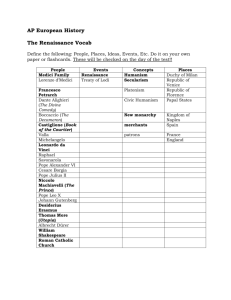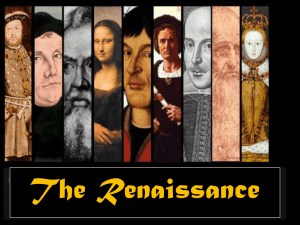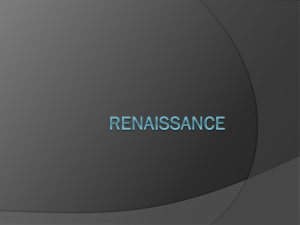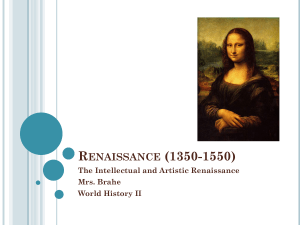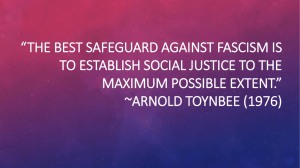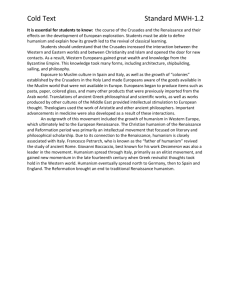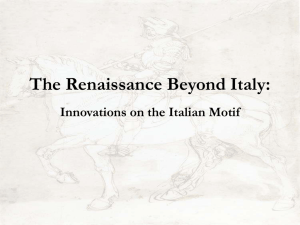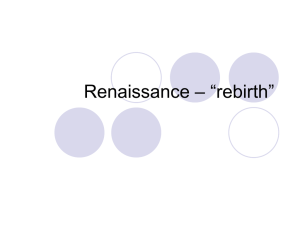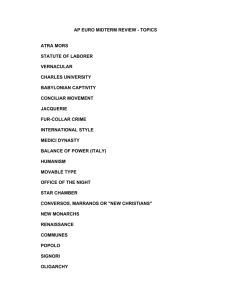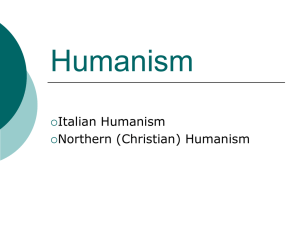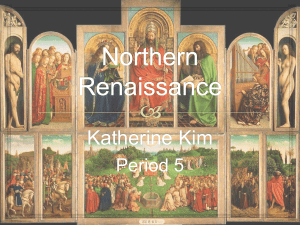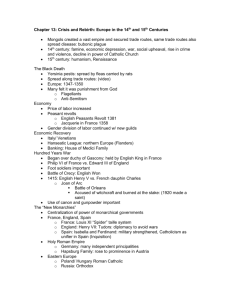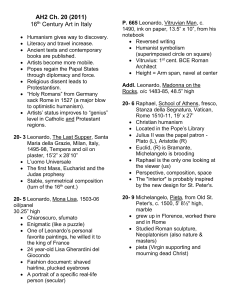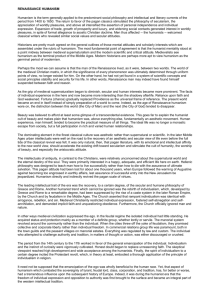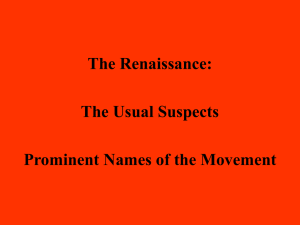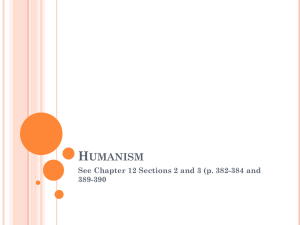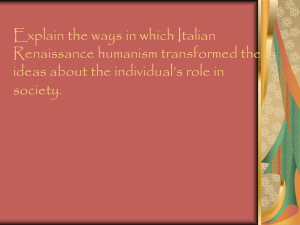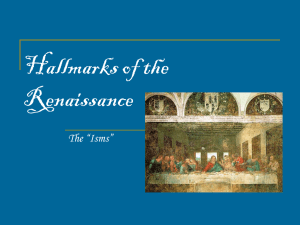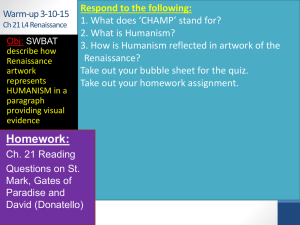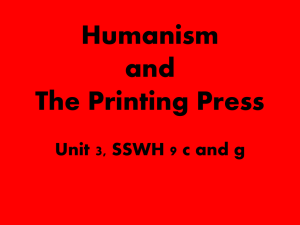The Renaissance - University of South Alabama
advertisement
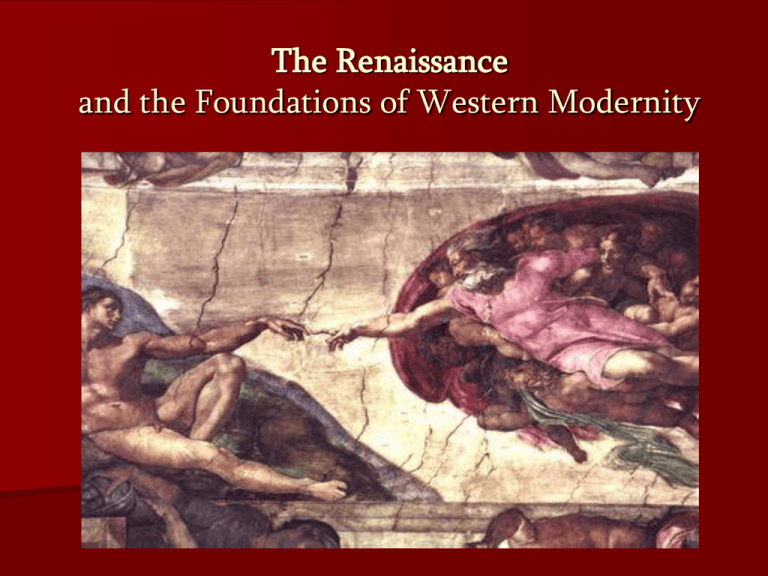
The Renaissance and the Foundations of Western Modernity I. Cultural change in crisis A. Theological challenges 1. John Wycliffe - quality of sacrament - Church authority 1320-1384 2. Jan Hus 1369-1415 - religion and nationalism - language čšž 3. Increased threat of Heresy - Waldensians no authority but the Bible - Albigensians extreme ascetism “Heretics” often preached austerity not found in Church, popular w/ peasants The Inquisition “what a show” 4. William of Ockham 1285-1349 - Argued against Aristotelian theory - must argue from specific to general Ockham’s razor scientific method B. Vernacular literature 1. Reliance on Latin declines - expression of cultural, national, religious independence (Gutenberg press) 2. Dante Alighieri The Divine Comedy 1321 allegory – historical figures, contemporary critique Redemption of Man – in Italian! “Abandon hope, all ye who enter here” 1308- 3. Geoffrey Chaucer The Canterbury Tales 1342-1400 - middle English - ribald, low brow comedy, social satire 4. Christine de Pizan City of Ladies a. status of aristocratic women improving b. all levels of patriarchy challenged 1364-1430 Giovanni Boccaccio Juan Ruiz The Decameron The Book of Good Love - “Mr. Melon of the Vegetable Garden” II. Awakenings Rebirth Overcoming constraints of the Middle Ages by re-discovering ancient ideas Humanism Theocratic culture vs. Humanism It ain‘t no sin to be glad you‘re alive. A. Luxury and lifestyle 1. Plague and commodities 2. Merchant republics Byzantine trade routes “bourgeois” culture (1100s) the Medici family Lorenzo de Medici, il magnifico The Florence trade route Platonic Academy of Florence Papal creditor Jakob Fugger Multinational company, mining, banking, fur&textile trade „Creditor of the Empire“ Augsburg B. Crafts and guilds 1. primacy of skilled workers - art and status C. Fall of the Byzantine Empire 1. “Practical” humanism 1453, Constantinople falls to Ottoman Turks - liberal arts education - monasticism v. humanism = contemplative v. activist lifestyle III. Renaissance Idealism A. The Humanistic Tradition 1. Petrarch “Father of Humanism” 1304-1374 - Study of classical history, philosophy, language - artist (writer) at center of art 2. Giovanni Pico della Mirandola 1463-1494 - Oration on the Dignity of Man Great Chain of Being v. Neo-Platonism - “progressive” outlook on politics, psychology & history B. Christian Humanism 1. Thomas Moore 1478-1535 - Utopia tolerance, equality, pacifism - Social Gospel: revolutionary or reactionary? 2. Erasmus In Praise of Folly 1509 - Church inconsistencies Moore/Erasmus - restore direct connection between individual & textual basis of Christianity 3. Literary Criticism - methods and goals - philology Polyglot Bible IV. Renaissance Style, 1400 - 1500 A. Reason and art 1. Use of proportion/ perspective (da Vinci) Scientific rebirth – Leonardo da Vinci The Last Supper, 1483 2. Study of anatomy Scientific research by artists Leonardo da Vinci – „Anatomic Studies“, 1480s B. Classicism 1. Neoplatonism (Michelangelo) fused classical with newer techniques art should reflect spiritual, metaphysical evolution art should reflect man’s rise to “godliness” Donatello Bronze sculptures Greek myths – perfection of nature Men as God´s children Albrecht Dürer – „Self Portrait“, 1500 B. The Northern Renaissance Flemish painters Albrecht Durer Jan van Eyck Jan Vermeer Peter Bruegel Rembrandt van Rijn interest in business class „Burgeois paintings“ Jan van Eyck – „Portrait of Jan de Leeuw“, 1436 Perfection – St. Peter´s Basilica 1546-1564 A Medici becomes Pope Italy´s best: – – – – Bramante Bernini Raphael Michelangelo Humanism – the new theology The icing on the cake – The Sistine Chapel Michelangelo, „Last Judgement“, 1530s The Sistine Chapel Michelangelo , „Genesis“, 1530s
